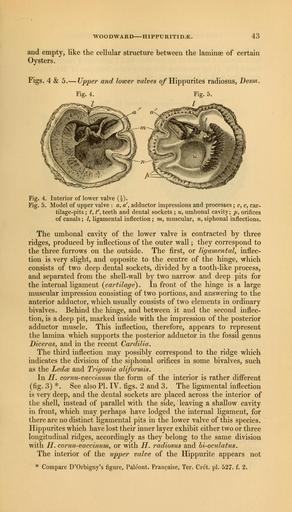MAKE A MEME
View Large Image

| View Original: | The_Quarterly_journal_of_the_Geological_Society_of_London_(12711766224).jpg (1828x3200) | |||
| Download: | Original | Medium | Small | Thumb |
| Courtesy of: | commons.wikimedia.org | More Like This | ||
| Keywords: The Quarterly journal of the Geological Society of London (12711766224).jpg WOODWARD HIPPURITIDiE <br> 43 <br> and empty like the cellular structure between the laminae of certain <br> Oysters <br> Figs 4 5 ” Upper and lower valves q/ Hippurites radiosus Desm <br> Fig 4 <br> Fig 5 <br> Fig <br> Fig <br> 4 Interior of lower valve <br> 5 Model of upper valve a a' adductor impressions and processes ; c c car- <br> tilage-pits ; t f teeth and dental sockets ; u umbonal cavity; p orifices <br> of canals ; I ligamental inflection ; m muscular n siphonal inflections <br> The umbonal cavity of the lower valve is contracted by three <br> ridges produced by inflections of the outer wall ; they correspond to <br> the three furrows on the outside The first or ligamental inflec- <br> tion is very slight and opposite to the centre of the hinge which <br> consists of two deep dental sockets divided by a tooth-like process <br> and separated from the shell-wall by two narrow and deep pits for <br> the internal ligament cartilage In front of the hinge is a large <br> muscular impression consisting of two portions and answering to the <br> anterior adductor which usually consists of two elements in ordinary <br> bivalves Behind the hinge and between it and the second inflec- <br> tion is a deep pit marked inside with the impression of the posterior <br> adductor muscle This inflection therefore appears to represent <br> the lamina which supports the posterior adductor in the fossil genus <br> Dicer as and in the recent Cardilia <br> The third inflection may possibly correspond to the ridge which <br> indicates the division of the siphonal orifices in some bivalves such <br> as the LedcE and Trigonia aliformis <br> In H cornu-vaccinum the form of the interior is rather diff'erent <br> fig 3 See also PI IV figs 2 and 3 The ligamental inflection <br> is very deep and the dental sockets are placed across the interior of <br> the shell instead of parallel with the side leaving a shallow cavity <br> in front which may perhaps have lodged the internal ligament for <br> there are no distinct ligamental pits in the lower valve of this species <br> Hippurites which have lost their inner layer exhibit either two or three <br> longitudinal ridges accordingly as they belong to the same division <br> with H cornu-vaccinum or with H radiosus and bi-oculatus <br> The interior of the upper valve of the Hippurite appears not <br> Compare D'Orbigny's figure Paleont Fran aise Ter Cret pi 527 f 2 35614603 110213 51125 Page 43 Text v 11 http //www biodiversitylibrary org/page/35614603 1855 Geological Society of London NameFound Cardilia NameConfirmed Cardilia EOLID 4771581 NameBankID 4103708 NameFound H cornu-vaccinum NameFound Hippurites NameConfirmed Hippurites EOLID 4773611 NameBankID 4195877 NameFound Hippurites radiosus NameConfirmed Hippurites radiosus NameBankID 6868549 NameFound Trigonia aliformis Biodiversity Heritage Library The Quarterly journal of the Geological Society of London v 11 1855 Geology Periodicals Smithsonian Libraries bhl page 35614603 dc identifier http //biodiversitylibrary org/page/35614603 smithsonian libraries Information field Flickr posted date ISOdate 2014-02-23 Check categories 2015 August 26 CC-BY-2 0 BioDivLibrary https //flickr com/photos/61021753 N02/12711766224 2015-08-26 20 58 09 cc-by-2 0 PD-old-70-1923 The Quarterly journal of the Geological Society of London 1855 Photos uploaded from Flickr by Fæ using a script | ||||